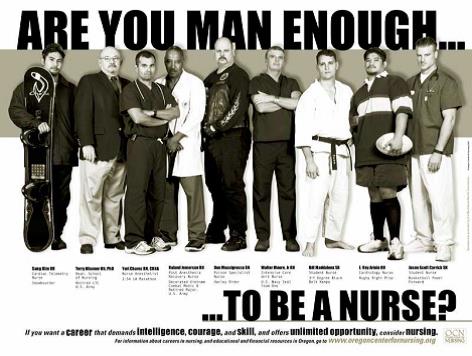While it is cliché to think that men are not as caring or compassionate as women, women are still much more likely to enter caring professions, such as nursing, than men. Men make up about 7% of the nursing workforce in the U.S. and their experiences as a numerical minority have been a rich source for advancing gender scholarship (i.e., Williams’ notion of the “glass escalator” that propels men to faster advancement in female-dominated fields). But what about organizational efforts to recruit men to nursing? How do recruitment efforts address conflicting notions of the ideal nurse as emotionally engaged, empathetic and helping others, while ideal masculinity gets portrayed as emotionally detached, tough and risk-taking?
While there has been significant attention to recruiting women into male-dominated fields, scholars have been less attentive to the converse – recruiting men to female-dominated fields. My research analyzes the recruitment strategies of key health care players as they seek to attract men to the nursing profession, examining the role of masculinities in the text, speech, and images of recruitment materials. Results reveal how organizations mobilize different forms of masculinity in order to recruit men and, in doing so, how their practices reaffirm or critique what it means to be a man.
Some recruitment items, like this early poster from the Virginia Partnership for Nursing, asked viewers “Are you man enough to be a nurse?” Aspects of hegemonic masculinity—characteristics associated with being the culturally defined “ideal man”—are common themes in the poster:
Sports, military service, risk-taking, and an emotionally-reserved demeanor are glamorized in the poster.
Since the “Are You Man Enough?” campaign in the early 2000’s, nurse leaders have tried to make recruitment messages less ostensibly gendered. In discussing the American Assembly for Men in Nursing’s (AAMN) new campaign, Anderson notes: “nursing recruitment efforts needed to evolve from asking men if they were masculine enough to be a nurse to something less gender specific.”
Despite the effort to “de-genderify” nursing (Anderson’s word), masculinity is still front and center. Though the slogan is different, materials continue to emphasize culturally idealized forms of masculinity. One of the AAMN’s newest posters, “Adrenaline Rush,” avoids the “man enough” rhetoric, but maintains the theme of a stoic, emotionally-detached masculinity through visual cues.
Most of the nurse’s face is covered – limiting emotional expression—while risk-taking is emphasized.
Of the 32 items included in the analysis, 7 (22 percent) relied on only hegemonic ideals in their messages to recruit men—a strategy that I term full hegemonic co-option. Using this strategy, organizations rely on and reaffirm masculine stereotypes in order to sell nursing to men. A prime example is the “Are you man enough?” poster above and this clip on travel nursing: here.
A second strategy used in the materials presents alternative forms of masculinity, subtly critiquing the macho ideals of stoicism and emotional detachment. I term this strategy alternative construction of masculinity. Eight (25 percent) of the recruitment materials used it. Johnson & Johnson’s 30-second clip “Name Game” illustrates this strategy in its portrayal of a caring and emotionally competent nurse: here.
A third strategy of recruitment employed by organizations is the combination of hegemonic and alternative masculinities, or partial hegemonic co-option. Seventeen items used this strategy (53 percent), making it the most common. The underlying message is that men can be caring nurses, but they can also be manly men. These themes, however, appear polarized, as men in the materials are cast as one type or the other. The opening sequence in this California Institute for Nursing and Health Care video shows the contrast between men who embody the hegemonic ideals of being tough, independent, and financially-driven and those who emphasize caring for others: click here.
Key health care players, including an international organization (Johnson & Johnson), urban hospital systems, nursing programs, and organizations like the American Assembly for Men in Nursing (AAMN) have devoted resources to recruiting men into nursing. Analyzing their recruitment strategies reveals as much about contemporary tensions within masculinity as it does about the profession’s push for gender diversity.
By Marci Cottingham on her article, “Recruiting Men, Constructing Manhood: How Health Care Organizations Mobilize Masculinities as Nursing Recruitment Strategy,” published in the February 2014 issue of Gender & Society. Marci Cottingham is a postdoctoral fellow in the department of Social Medicine at the University of North Carolina – Chapel Hill. She received her Ph.D. in sociology from the University of Akron. Her research spans issues of gender, emotion, health, and healthcare. For more on her work, click here.


14 thoughts on “Recruiting men, constructing manhood: How health care organizations mobilize masculinities as nursing recruitment strategy”